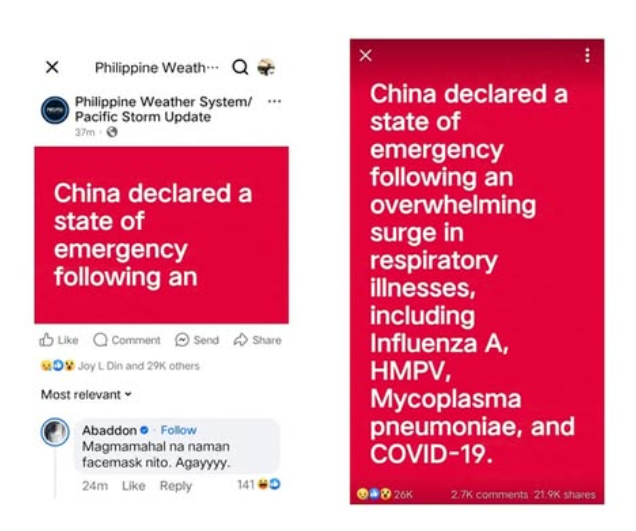In recent weeks, various unverified reports and rumors have circulated online, claiming that China has declared a state of emergency due to epidemics overwhelming hospitals and crematoriums. These alarming assertions have sparked widespread concern and speculation. However, upon careful examination of available data and official statements, it becomes evident that these claims lack credibility and are not backed by reliable evidence. This report aims to dissect these rumors, analyze their origins, and highlight the importance of relying on credible sources for information.Overview of the ClaimsThe claims suggest that China’s healthcare system is under immense strain due to a resurgence of epidemics, leading to a state of emergency declaration. Allegations include overwhelmed hospitals, long queues at crematoriums, and a dire public health crisis that has prompted extreme measures. The narrative is often accompanied by dramatic language and sensational headlines, aimed at capturing attention.While the potential for public health crises is a reality in any nation, the specifics of these claims warrant scrutiny. Neither the Chinese health department nor the World Health Organization (WHO) has issued any official statements to corroborate the allegations. This discrepancy raises significant doubts about the authenticity of the claims.Lack of Official ConfirmationOne of the most critical indicators of misinformation is the absence of corroboration from reputable sources. The Chinese government, known for its centralized approach to public health and crisis management, has not released any emergency declarations regarding the alleged epidemic situation. Furthermore, the WHO, a global authority on public health issues, has not flagged any such developments in China.In previous instances of public health crises, such as the COVID-19 pandemic, both China and the WHO issued regular updates and transparent communication about the situation. The lack of similar statements in this case strongly suggests that the claims are baseless.Misinformation and Its SpreadMisinformation tends to spread rapidly, especially on social media platforms where sensational content often garners more attention than verified information. In this instance, vague videos, unverified images, and anecdotal accounts have been shared widely, contributing to the proliferation of the narrative.Role of Social Media: Platforms like Twitter, Facebook, and TikTok have been central to spreading these rumors. Accounts with large followings have amplified unverified content, creating an echo chamber of misinformation.Use of Anonymous Sources: Many posts cite anonymous or unverifiable sources, making it difficult to trace the origin of the claims.Visual Manipulation: Images purportedly showing overwhelmed hospitals and crematoriums are often taken out of context or are from unrelated events. This tactic is commonly used to lend credibility to false claims.Current Health Situation in ChinaWhile no credible reports support the claim of a state of emergency, it is essential to consider the broader context of China’s public health situation. Like many countries, China faces periodic challenges in managing its healthcare system, particularly during seasonal outbreaks of flu or other illnesses. However, these challenges do not equate to a nationwide emergency.Healthcare Infrastructure: China has invested heavily in its healthcare infrastructure over the past two decades. Major cities like Beijing, Shanghai, and Guangzhou have modern hospitals equipped to handle significant patient inflows.Surveillance Systems: The Chinese Center for Disease Control and Prevention (CDC) operates an extensive surveillance network to monitor and respond to health threats. This system is designed to detect and address public health emergencies promptly.Comparative Analysis: COVID-19 PandemicThe ongoing speculation draws parallels to the early days of the COVID-19 pandemic when information about the virus’s spread in Wuhan was limited and uncertain. However, there are critical differences:Transparency: During COVID-19, the Chinese government and the WHO issued frequent updates about the situation. The absence of such communication now strongly indicates that the current claims are exaggerated or fabricated.Global Collaboration: During past public health crises, international collaborations provided additional verification of the situation. No such collaborations have emerged to support the recent rumors.Impact of MisinformationThe spread of misinformation has far-reaching consequences, not only for public perception but also for broader societal impacts.Panic and Fear: Sensational claims about health crises can lead to widespread panic, causing unnecessary strain on healthcare facilities and other resources.Erosion of Trust: Frequent exposure to unverified information undermines public trust in official channels and credible institutions.Economic Repercussions: False claims about public health emergencies can negatively affect tourism, trade, and investment, particularly for the regions implicated.Role of Media in Verifying InformationMedia organizations and fact-checkers play a critical role in countering misinformation. Responsible reporting involves:Consulting Credible Sources: Journalists must rely on official statements from health departments, the WHO, and other authoritative bodies.Providing Context: Reports should include context about the images or videos used to ensure they are not misinterpreted.Educating the Public: Media outlets should educate their audiences on how to identify and avoid misinformation.What Can Individuals Do?In an era of information overload, individuals must exercise caution when encountering sensational claims. Here are some steps to consider:Verify Sources: Cross-check information with reputable outlets and official channels.Avoid Sharing Unverified Content: Sharing unverified information contributes to the spread of misinformation.Seek Expert Opinions: Rely on experts and credible organizations for insights into complex issues.ConclusionThe claim that China has declared a state of emergency over epidemics lacks credible evidence and official confirmation. Both the Chinese health department and the WHO have remained silent on these allegations, further discrediting their validity. While it is crucial to remain vigilant about potential public health threats, it is equally important to rely on accurate and verified information.The rapid spread of unverified claims underscores the need for collective responsibility in combating misinformation. Governments, media organizations, and individuals must work together to ensure that public discourse is informed by facts rather than fear.By emphasizing truthfulness, transparency, and critical thinking, we can foster a more informed and resilient society capable of navigating the challenges of the information age.




